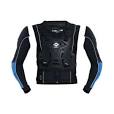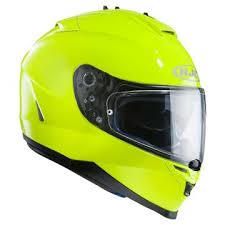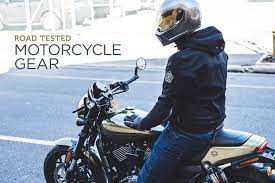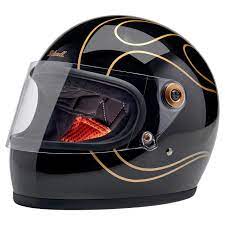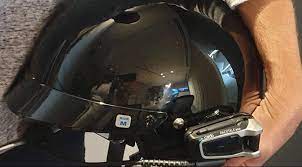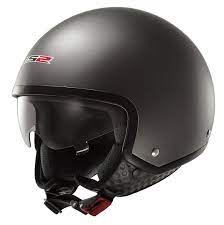
The Open Face Helmet with Visor: The Perfect Blend of Style and Functionality
When it comes to motorcycle helmets, there are countless options available on the market. However, one particular style that has gained popularity among riders is the open face helmet with a visor. Combining style, comfort, and functionality, this helmet design offers a unique riding experience.
One of the key features of an open face helmet with a visor is its versatility. Unlike full-face helmets that enclose the entire head, open face helmets provide riders with a sense of freedom and openness while still offering essential protection. The absence of a chin bar allows for better ventilation and an unobstructed view of the surroundings, making it an ideal choice for urban commuting or leisurely rides through scenic routes.
The addition of a visor further enhances the practicality of this helmet design. The visor acts as a shield against wind, debris, and insects, ensuring clear vision and preventing distractions while riding. It also provides protection from harmful UV rays, reducing eye strain during long journeys under the sun. With the ability to be easily flipped up or down, riders can quickly adjust their visibility depending on weather conditions or personal preference.
Aside from its functional benefits, an open face helmet with a visor is also favored by many for its stylish appeal. With various designs and finishes available, riders can choose a helmet that matches their personal taste and complements their overall riding gear. Whether you prefer classic retro aesthetics or modern sleek designs, there is an open face helmet with a visor to suit every style.
Safety should always be a top priority when selecting any motorcycle gear. While open face helmets may not provide the same level of protection as full-face helmets in terms of facial coverage, they still offer crucial head protection in case of accidents. It’s important to choose a high-quality helmet that meets safety standards and provides proper cushioning and impact resistance.
It’s worth noting that open face helmets with visors are not suitable for every riding situation. If you frequently engage in high-speed riding or off-road adventures, a full-face helmet may be more appropriate to ensure maximum protection. However, for urban commuting, leisurely rides, or when you simply want to enjoy the fresh air on the open road, an open face helmet with a visor can be an excellent choice.
In conclusion, the open face helmet with a visor combines style and functionality in a unique way. Its versatility, comfort, and practicality make it a popular choice among riders who value both protection and freedom. With its ability to provide clear vision while shielding against wind and debris, this helmet design offers an enjoyable riding experience. Remember to prioritize safety by choosing a well-constructed helmet that meets safety standards. So gear up, hit the road, and embrace the best of both worlds with an open face helmet with a visor.
7 Essential Tips for Open Face Helmets with Visors
- Make sure the helmet fits properly and is securely fastened when wearing it.
- Ensure the visor provides sufficient protection from wind, rain and debris while riding.
- Check that the visor is securely attached to the helmet before using it.
- Clean and maintain your open face helmet with visor regularly to keep it in good condition.
- Replace any damaged or worn parts of your open face helmet with visor as soon as possible for safety reasons.
- Use a transparent visor during night time riding for improved visibility in low light conditions.
- Wear sunglasses or goggles underneath your open face helmet with visor for added protection against UV rays and glare from the sun or headlights of other vehicles on the road
Make sure the helmet fits properly and is securely fastened when wearing it.
When it comes to motorcycle safety, wearing a helmet is crucial. And when you choose an open face helmet with a visor, it’s important to pay attention to one key aspect: ensuring that the helmet fits properly and is securely fastened.
A well-fitted helmet not only enhances your comfort but also plays a vital role in providing optimal protection. When trying on an open face helmet with a visor, make sure it sits snugly on your head without any excessive pressure points. It should feel secure but not overly tight or loose.
To determine the right fit, start by measuring your head circumference using a measuring tape. Then refer to the manufacturer’s size chart to find the appropriate helmet size. Remember that different brands may have slightly different sizing standards, so always consult the specific brand’s guidelines.
Once you’ve found the right size, try the helmet on and adjust its fit using any available retention systems or straps. The chin strap should be securely fastened and snugly fit under your chin, allowing for minimal movement when you shake your head gently. Ensure that the strap doesn’t cause discomfort or irritation while riding.
A properly fitted and securely fastened open face helmet with a visor offers several benefits. Firstly, it minimizes the risk of the helmet coming off during an accident or sudden impact. Secondly, it reduces wind noise and prevents excessive movement while riding at high speeds. Lastly, it ensures that the visor stays in place and provides uninterrupted visibility throughout your journey.
Remember that helmets can naturally loosen over time due to wear and tear or repeated use. Therefore, it’s essential to regularly check and readjust the fit of your open face helmet with a visor for optimal safety and comfort.
In conclusion, when wearing an open face helmet with a visor, always prioritize proper fitment and secure fastening. This simple yet critical step significantly enhances your safety while riding. A well-fitted helmet ensures maximum protection, comfort, and visibility throughout your adventures on the road. So, take the time to find the right size, adjust the fit correctly, and enjoy your rides with peace of mind.
Ensure the visor provides sufficient protection from wind, rain and debris while riding.
When it comes to riding with an open face helmet equipped with a visor, ensuring proper protection from wind, rain, and debris is essential for a safe and comfortable experience. The visor serves as a shield, keeping your eyes and face shielded from external elements while you enjoy your ride.
One of the primary functions of the visor is to protect your eyes from wind turbulence. Riding at high speeds can create strong gusts of wind that can cause discomfort and even impair your vision. A well-fitted visor should create a barrier against these gusts, allowing you to ride without squinting or straining your eyes.
Rainy weather can pose additional challenges for riders. The visor should be designed to provide sufficient protection against raindrops, preventing them from obstructing your vision. Look for visors with anti-fog coatings or features that minimize condensation build-up on the inside, as this will help maintain clear visibility during wet conditions.
Debris such as dust, insects, or small particles can also be a nuisance while riding. A properly fitted visor acts as a barrier against these elements, preventing them from directly hitting your face. This not only keeps you comfortable but also reduces distractions that could potentially affect your focus on the road.
To ensure that the visor provides optimal protection, it’s crucial to choose a high-quality helmet with a well-designed visor system. Look for helmets that have undergone rigorous testing and meet safety standards. Additionally, check if the helmet offers different visor options such as tinted or mirrored versions for varying light conditions.
Regular maintenance of the visor is equally important in ensuring its effectiveness over time. Keep it clean by using appropriate cleaning solutions and microfiber cloths to avoid scratching the surface. Inspect it regularly for any signs of wear or damage and replace it if necessary.
Remember that while an open face helmet with a visor offers great visibility and ventilation compared to full-face helmets, it may not provide the same level of protection. Consider the type of riding you will be doing and the potential risks involved to make an informed decision about the helmet that best suits your needs.
In conclusion, choosing an open face helmet with a visor can offer a fantastic riding experience, provided that the visor provides sufficient protection from wind, rain, and debris. Prioritize safety by selecting a high-quality helmet and maintaining the visor properly. By doing so, you can enjoy your ride with peace of mind, knowing that your eyes and face are shielded from external elements along the way.
Check that the visor is securely attached to the helmet before using it.
Ensuring Safety: Securely Attached Visor on Your Open Face Helmet
When it comes to motorcycle safety, every detail matters. One crucial aspect often overlooked is the attachment of the visor to your open face helmet. Before hitting the road, it’s essential to check that the visor is securely fastened to your helmet for optimal protection and a hassle-free ride.
A securely attached visor not only ensures clear vision but also guards against potential hazards such as wind, debris, and insects. Imagine cruising down the road when suddenly your visor starts to wobble or, worse, detaches completely. This can be not only distracting but also dangerous, compromising your ability to focus on the road ahead.
To avoid such risks, take a moment to inspect the attachment mechanism of your open face helmet’s visor before setting off on any ride. Here are a few simple steps you can follow:
- Examine the Fastening Mechanism: Different helmets may have varying methods of securing the visor in place. It could be through snap-on buttons, screws, or other mechanisms specific to your helmet model. Familiarize yourself with how the visor attaches and ensure that all fasteners are intact and functioning correctly.
- Test for Stability: Gently tug on the visor once it’s attached to check its stability. It should remain firmly in place without any excessive movement or looseness. If you notice any wobbling or instability, it’s crucial to address the issue before riding.
- Verify Locking Mechanisms: Some helmets have additional locking mechanisms that secure the visor in place once it is closed fully. Make sure these locks are engaged properly and hold the visor securely without any play.
- Regular Maintenance: Regularly inspect and clean both your helmet and its visor as part of routine maintenance. Dust, dirt, or debris accumulation can affect how well they fit together and potentially compromise the attachment mechanism. Clean them with a soft cloth and mild soap, following manufacturer guidelines.
By taking these precautionary steps, you can ensure that your open face helmet’s visor remains securely attached throughout your ride. This not only enhances your safety but also provides peace of mind, allowing you to fully enjoy the open road without unnecessary distractions.
Remember that a securely attached visor is just one aspect of overall motorcycle safety. Always wear appropriate protective gear, follow traffic laws, and ride responsibly. Prioritizing safety is key to enjoying the exhilaration of motorcycling while minimizing potential risks.
So, before embarking on your next two-wheeled adventure, take a moment to check that your visor is securely attached to your open face helmet. It’s a small but significant step towards ensuring a safe and enjoyable ride.
Clean and maintain your open face helmet with visor regularly to keep it in good condition.
Clean and Maintain Your Open Face Helmet with Visor: A Key to Longevity and Performance
Your open face helmet with a visor is not just a piece of protective gear; it’s an essential companion on your motorcycle journeys. To ensure its longevity and optimal performance, regular cleaning and maintenance are crucial. By following a few simple steps, you can keep your helmet in good condition for years to come.
First and foremost, always refer to the manufacturer’s instructions for specific cleaning recommendations. Start by removing the visor from the helmet, if possible, as this will make the cleaning process easier. Use a mild soap or helmet cleaner specifically designed for visors to gently clean both the inside and outside surfaces. Avoid using harsh chemicals or abrasive materials that could damage the visor’s clarity or protective coating.
When cleaning the shell of your open face helmet, use a soft cloth or sponge dampened with mild soapy water. Gently wipe away any dirt, grime, or bugs that may have accumulated during your rides. Pay extra attention to areas prone to sweat buildup like the inner padding and strap. If removable, hand wash these components following the manufacturer’s instructions.
After cleaning, thoroughly rinse off any soap residue with clean water and allow all parts to air dry naturally. Avoid using excessive heat sources like hairdryers or direct sunlight as they can deform or damage certain materials.
Regularly inspect your open face helmet for any signs of wear and tear such as cracks, loose padding, or damaged straps. If you notice any issues, consult with a professional or contact the manufacturer for guidance on repairs or replacements.
Proper storage is also essential in maintaining your helmet’s condition. Keep it in a cool, dry place away from direct sunlight and extreme temperatures that could degrade its integrity over time. Avoid stacking heavy objects on top of it to prevent deformation.
Lastly, don’t forget about hygiene! Helmets can develop unpleasant odors due to sweat and bacteria buildup. Consider using helmet deodorizers or fresheners specifically designed for this purpose. If your helmet has removable padding, follow the manufacturer’s instructions on how to clean or replace it.
By regularly cleaning and maintaining your open face helmet with a visor, you not only ensure its longevity but also guarantee optimal performance and comfort. A well-maintained helmet will provide you with the necessary protection and clear visibility, enhancing your riding experience every time you hit the road.
So, make it a habit to give your open face helmet with a visor some TLC after each ride. Your helmet will thank you by keeping you safe and stylish on all your motorcycle adventures!
Replace any damaged or worn parts of your open face helmet with visor as soon as possible for safety reasons.
Ensuring Safety: Replace Damaged or Worn Parts of Your Open Face Helmet with Visor
When it comes to motorcycle safety, the condition of your gear plays a crucial role. Amongst the essential pieces of equipment is your open face helmet with a visor. While these helmets offer comfort and protection, it is important to regularly inspect and maintain them to ensure optimal safety on the road.
One vital tip to follow is to replace any damaged or worn parts of your open face helmet with a visor as soon as possible. This may include the visor itself, straps, padding, or other components that have experienced wear and tear over time.
Why is this so important? Well, damaged or worn parts can compromise the effectiveness of your helmet in protecting you during an accident or collision. A cracked visor may hinder your visibility, making it difficult to anticipate hazards on the road. Worn-out straps may not secure the helmet properly, reducing its stability and increasing the risk of it coming off during impact. Similarly, deteriorated padding may fail to provide adequate cushioning in case of a crash.
By promptly replacing any damaged or worn parts, you ensure that your open face helmet with visor remains in top-notch condition for maximum safety. Regularly inspecting your helmet and addressing any issues can help prevent potential accidents and minimize injuries.
To keep your open face helmet in good shape, follow these simple steps:
- Regularly examine all components: Inspect the visor, straps, padding, and other parts for signs of damage or wear. Look for cracks, tears, loose fittings, or any abnormalities that may affect their functionality.
- Replace damaged parts: If you notice any issues during inspection, take immediate action to replace the damaged part(s). Consult with a reputable dealer or manufacturer to ensure you get compatible replacements that meet safety standards.
- Follow manufacturer’s guidelines: Always refer to the manufacturer’s instructions for proper maintenance and replacement procedures. They will provide specific guidelines on when and how to replace different parts of your helmet.
- Invest in quality: When purchasing replacement parts, opt for high-quality components that are designed to fit your helmet model. Don’t compromise on safety by choosing cheaper, substandard options.
Remember, your open face helmet with visor is a critical piece of protective gear that can save your life in case of an accident. Regularly inspecting and replacing damaged or worn parts ensures that it remains in optimal condition, providing you with the necessary protection on every ride.
Prioritize safety by taking this simple yet significant step to maintain your open face helmet with visor. By doing so, you can enjoy the freedom of the open road with peace of mind, knowing that you have taken every precaution to keep yourself safe while riding.
Use a transparent visor during night time riding for improved visibility in low light conditions.
Enhancing Night Riding Safety: The Importance of a Transparent Visor on Your Open Face Helmet
When it comes to riding motorcycles at night, ensuring optimal visibility is crucial for your safety. While open face helmets with visors offer great versatility, it’s important to make the right choice when it comes to selecting the visor for your nighttime adventures.
One valuable tip for night riding is to use a transparent visor on your open face helmet. Unlike tinted or mirrored visors that are commonly used during the day to reduce glare and shield against bright sunlight, a transparent visor allows maximum light transmission, improving visibility in low light conditions.
Nighttime riding presents its own set of challenges. With reduced ambient light and potential glare from streetlights and oncoming vehicles, having a clear and unobstructed view becomes even more critical. By using a transparent visor, you can minimize any distortion or color alteration that might occur with tinted or mirrored options, allowing you to see the road ahead more accurately.
Another advantage of a transparent visor is its ability to enhance contrast. It helps in distinguishing objects, road markings, and potential hazards more clearly in low light conditions. This improved contrast can significantly contribute to your overall perception and reaction time while riding at night.
Additionally, using a transparent visor during nighttime rides ensures that other road users can see your face clearly. This visibility can be particularly important when it comes to communicating non-verbally with other riders or drivers on the road. It also helps in maintaining good peripheral vision by preventing any unnecessary distractions caused by tinted or mirrored surfaces.
While using a transparent visor is highly recommended for night riding, it’s essential to remember that proper lighting on your motorcycle is equally important. Ensure that your headlights are in good working condition and properly aligned for maximum illumination of the road ahead.
Remember, safety should always be a top priority when enjoying nighttime rides on your motorcycle. By using a transparent visor, you can enhance your visibility, improve contrast, and ensure that you have a clear view of the road. So gear up, stay safe, and enjoy the thrill of riding under the stars with confidence.
Wear sunglasses or goggles underneath your open face helmet with visor for added protection against UV rays and glare from the sun or headlights of other vehicles on the road
Enhance Your Ride: Wear Sunglasses or Goggles with Your Open Face Helmet Visor
When it comes to riding motorcycles, safety and comfort should always be a top priority. While an open face helmet with a visor provides excellent protection against wind and debris, there’s a simple tip that can further enhance your riding experience: wear sunglasses or goggles underneath your helmet.
One of the key benefits of wearing sunglasses or goggles with your open face helmet visor is the added protection against harmful UV rays. The sun’s rays can be harsh on the eyes, especially during long rides or when riding in bright conditions. By wearing sunglasses or goggles, you create an extra layer of defense for your eyes, shielding them from UV radiation and reducing the risk of eye strain.
Additionally, sunglasses or goggles offer protection against glare. Whether it’s the sun reflecting off other vehicles’ windshields or the headlights of oncoming traffic at night, glare can significantly affect your vision and compromise safety on the road. By wearing sunglasses or goggles underneath your helmet visor, you minimize glare and ensure clear visibility, allowing you to focus on the road ahead without distractions.
Comfort is another aspect to consider. Sunglasses or goggles provide an additional barrier against wind, preventing dry eyes and reducing discomfort caused by excessive airflow. They also act as a shield against dust and debris that may find their way into your eyes while riding.
It’s important to choose sunglasses or goggles that are suitable for motorcycle riding. Look for options that offer UV protection, polarized lenses to reduce glare, and a secure fit to ensure they stay in place while riding. There are various styles available to match your personal preference and riding gear.
Remember to adjust your sunglasses or goggles accordingly depending on lighting conditions. For example, if you’re riding at night or in low-light situations, it may be best to remove them altogether as they can hinder visibility in such conditions.
By incorporating this simple tip of wearing sunglasses or goggles with your open face helmet visor, you can enhance both your safety and comfort on the road. Protecting your eyes from UV rays and reducing glare ensures a clearer view of the surroundings, allowing you to fully enjoy your ride without compromising on safety.
So, before you hit the road, don’t forget to grab your sunglasses or goggles and experience the benefits they bring when paired with your open face helmet visor. Ride safely, comfortably, and confidently while enjoying the beauty of the open road.

